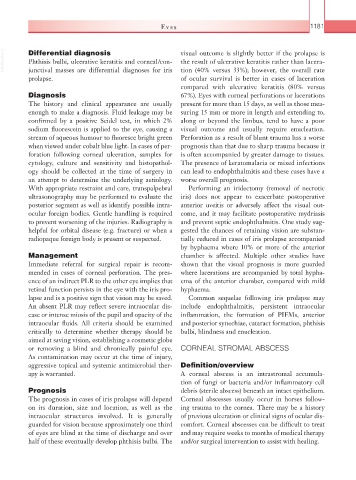Page 1206 - Equine Clinical Medicine, Surgery and Reproduction, 2nd Edition
P. 1206
Eyes 1181
VetBooks.ir Differential diagnosis visual outcome is slightly better if the prolapse is
the result of ulcerative keratitis rather than lacera-
Phthisis bulbi, ulcerative keratitis and corneal/con-
junctival masses are differential diagnoses for iris
of ocular survival is better in cases of laceration
prolapse. tion (40% versus 33%); however, the overall rate
compared with ulcerative keratitis (80% versus
Diagnosis 67%). Eyes with corneal perforations or lacerations
The history and clinical appearance are usually present for more than 15 days, as well as those mea-
enough to make a diagnosis. Fluid leakage may be suring 15 mm or more in length and extending to,
confirmed by a positive Seidel test, in which 2% along or beyond the limbus, tend to have a poor
sodium fluorescein is applied to the eye, causing a visual outcome and usually require enucleation.
stream of aqueous humour to fluoresce bright green Perforation as a result of blunt trauma has a worse
when viewed under cobalt blue light. In cases of per- prognosis than that due to sharp trauma because it
foration following corneal ulceration, samples for is often accompanied by greater damage to tissues.
cytology, culture and sensitivity and histopathol- The presence of keratomalacia or mixed infections
ogy should be collected at the time of surgery in can lead to endophthalmitis and these cases have a
an attempt to determine the underlying aetiology. worse overall prognosis.
With appropriate restraint and care, transpalpebral Performing an iridectomy (removal of necrotic
ultrasonography may be performed to evaluate the iris) does not appear to exacerbate postoperative
posterior segment as well as identify possible intra- anterior uveitis or adversely affect the visual out-
ocular foreign bodies. Gentle handling is required come, and it may facilitate postoperative mydriasis
to prevent worsening of the injuries. Radiography is and prevent septic endophthalmitis. One study sug-
helpful for orbital disease (e.g. fracture) or when a gested the chances of retaining vision are substan-
radiopaque foreign body is present or suspected. tially reduced in cases of iris prolapse accompanied
by hyphaema where 10% or more of the anterior
Management chamber is affected. Multiple other studies have
Immediate referral for surgical repair is recom- shown that the visual prognosis is more guarded
mended in cases of corneal perforation. The pres- where lacerations are accompanied by total hypha-
ence of an indirect PLR to the other eye implies that ema of the anterior chamber, compared with mild
retinal function persists in the eye with the iris pro- hyphaema.
lapse and is a positive sign that vision may be saved. Common sequelae following iris prolapse may
An absent PLR may reflect severe intraocular dis- include endophthalmitis, persistent intraocular
ease or intense miosis of the pupil and opacity of the inflammation, the formation of PIFMs, anterior
intraocular fluids. All criteria should be examined and posterior synechiae, cataract formation, phthisis
critically to determine whether therapy should be bulbi, blindness and enucleation.
aimed at saving vision, establishing a cosmetic globe
or removing a blind and chronically painful eye. CORNEAL STROMAL ABSCESS
As contamination may occur at the time of injury,
aggressive topical and systemic antimicrobial ther- Definition/overview
apy is warranted. A corneal abscess is an intrastromal accumula-
tion of fungi or bacteria and/or inflammatory cell
Prognosis debris (sterile abscess) beneath an intact epithelium.
The prognosis in cases of iris prolapse will depend Corneal abscesses usually occur in horses follow-
on its duration, size and location, as well as the ing trauma to the cornea. There may be a history
intraocular structures involved. It is generally of previous ulceration or clinical signs of ocular dis-
guarded for vision because approximately one third comfort. Corneal abscesses can be difficult to treat
of eyes are blind at the time of discharge and over and may require weeks to months of medical therapy
half of these eventually develop phthisis bulbi. The and/or surgical intervention to assist with healing.

